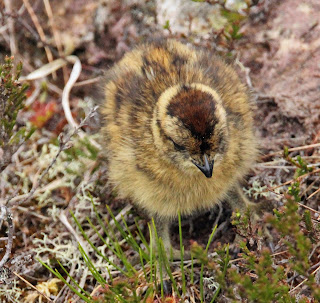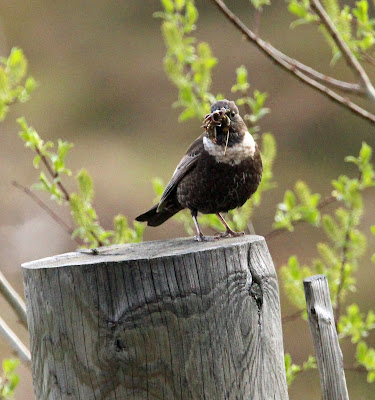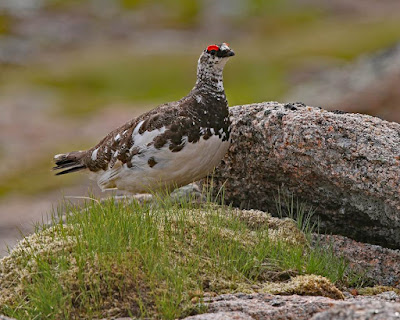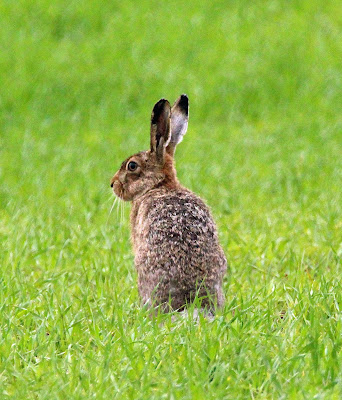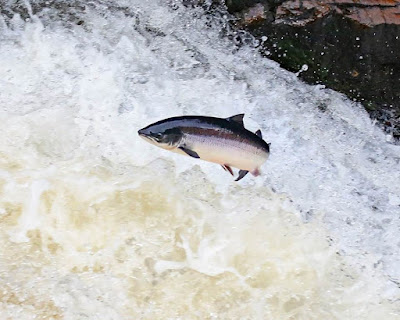July 2016 started unseasonably 'grey', cold and wet in this area, with temperatures and conditions often more akin to spring or autumn, but it warmed up considerably from mid-month, with the second half of the month turning out to be warm and showery, and as long as you had appropriate clothing to hand to deal with the changeable conditions, it was a very enjoyable and successful month for wildlife sightings, and although the days are shortening slightly now, this far north there are still around 18 hours of usable daylight.
Full-day safari bird species day lists dropped a little, down into the 40's, as some of our wader species moved away from their upland breeding territories to the coasts, and things have definitely quietened down , as just about every bird species seems to have successfully raised and fledged youngsters now.
Mammal day lists varied between 3 and 9, depending on the length of day, and variety of habitats visited...with early starts generally producing more and better sightings, with again, many species seen with youngsters..
When the sun did shine, with the heather starting to turn a beautiful vivid purple, and the wild flowers and butterflies at their most abundant, Speyside really was a beautiful and unspoilt place to be, and my safari clients, from many different countries, including Canada, USA, South Africa, Australia, Belgium and Holland all seemed to enjoy themselves.....
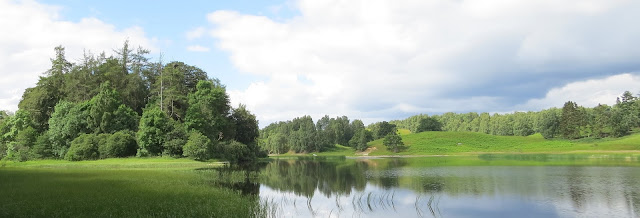 |
| Midsummer at a beautiful local loch |
To give you an idea of what you may realistically hope to see if you are planning a future July visit, I hope the following more detailed information, illustrated with photos taken by myself or my safari clients will help........
Wildlife highlights included:
Local speciality and upland bird species seen regularly throughout the month included: Osprey, Red Grouse, Slavonian Grebe, Red-Throated Diver, Black-Throated Diver, Crested Tit, Ring Ouzel, Goldeneye and Dipper.
We also enjoyed some regular good views of Peregrine, a few decent sightings of Golden Eagle, and a couple of fleeting glimpses of Scottish Crossbill, though sadly Capercaillie and Black Grouse (not unusually) were not seen at all this month....
Mammals seen regularly locally during the month included:
Red Squirrel,
Rabbit,
Brown Hare,
Roe Deer,
Red Deer,
Reindeer,
Mountain Goat, and
Bank Vole, with just a couple of sightings of
Mountain Hare,
Stoat, and another local upland speciality ,
Black Water Vole.
A coastal excursion to the Moray Firth mid-month on one of the warm and sunny days provided great views of
Seals ....
 |
| Newly-fledged young Osprey |
Our local
Ospreys stole the show again this month, often being voted as 'Bird of the day' by my safari clients, with the adult birds seen fishing, delivering fish, and encouraging the fast growing 'scaly' looking youngsters to take their 'maiden flights', and by late-month they had indeed fledged and were seen perched, flying and fishing for the first time.. I can therefore highly recommend July as THE month for
Osprey watching and photography in this area...
 |
| Red Grouse by Malcolm Fincham |
Red Grouse too
are always popular with my safari parties, as being a bird of uninhabited upland moors, most of my clients do not have them close to home. We, however, are fortunate to have lots of suitable heather moorland in this area, and throughout the month we enjoyed good close up views of families of these very characterful and beautifully marked birds.
 |
| Slavonian Grebe with chicks taking a ride by Steve Nicklin |
Slavonian (Horned) Grebe, one of our rarest and surely one of our most beautiful British breeding birds, with the UK being at the very western limits of it's breeding range , have often struggled to breed successfully in this area in recent years, so it was great to see two of our local nesting pairs with youngsters this month, and we even got to see the very rare sight of the cute 'humbug' striped chicks taking a ride on the parents backs...
 |
| Red-Throated Diver |
Divers (Loons) in their dapper summer plumage are always popular with my safari clients, and we were fortunate enough to get lots of good views of both
Red-Throated and
Black-Throated , both with well-grown youngsters,
on their favoured local lochs throughout the month. It should be noted however, that they are rarely seen close to the shore, and are easily disturbed by non wildlife-friendly tourists dog-walking, swimming and boating etc, so early morning starts in search of them usually gave us our closest sightings....
 |
| Male Ring Ouzel |
Ring Ouzels continued
to show
well in upland habitats near their nesting and feeding areas early in the month but became noticeably more elusive as the month progressed as they and their recently-fledged young began to roam further afield, and they appeared to have vacated this area for warmer climes by the end of the month....
 |
| Dipper |
Dipper sightings were a bit hit and miss this month, with the birds seemingly quite mobile up and down the rivers, some days we saw none, and on other days we saw one on each river we visited! Which just goes to show that sometimes you need a bit of luck......
Crested Tits still took a bit of finding in our local Caledonian pine forests, with the ability to identify them by their distinctive calls and songs being vital if you are to have a chance. The ones we did see were mainly in family groups, and constantly on the move....
It was a similar story with
Crossbills too, with the majority of our sightings being of the rather frustrating 'fly-over' variety, with them only being identified by their characteristic 'jip' 'jip' calls as they travelled between different parts of the forests...
Golden Eagle is probably hardest to see in mid-summer (in this area at least), as the birds have so many hours of daylight in which to hunt, but we did manage a few decent though distant views of birds soaring on thermals...
Still on raptors, we also saw
Peregrine,
Red Kite,
Common Buzzard,
Kestrel and
Sparrowhawk regularly during the month...
 |
| Golden Plover |
Other good birds of note seen this month included:
Bullfinches, usually at quiet forest feeding stations , Golden Plover on the moors, and families of Redstarts and Spotted Flycatchers catching insects in our local forests....
 |
| Spotted Flycatcher |
July is 'last chance saloon' for seeing all 3 of our mountain top species in one trip, and although I did not get the opportunity to take to the hills to see them myself, Ptarmigan, Dotterel and Snow Bunting were all reported by those that did...
Onto mammals now...
 |
| Red Squirrel |
The award for 'mammal of the day' , as voted for by my safari clients, invariably went to that ever popular peanut-munching forest dweller, the cute and charismatic Red Squirrel, who can usually be relied upon to appear for an easy feast at my favourite forest feeding stations.....
Roe Deer were seen frequently, at least early in the day anyway, and often heard 'barking' as they 'rutted' in suitable lowland areas.
 |
| Red Deer stags |
Red Deer were regularly seen in upland glens in large same-sex herds, the stags happily feeding and seemingly relaxing, and the hinds with their fast-growing young always nearby ....with many of my safari guests from foreign lands putting these iconic beasts high up on their 'wish-lists'....
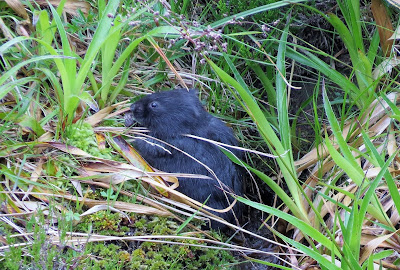 |
| Black water Vole by Bob Smith |
Water Voles of the 'brown' variety, although generally in decline, are not uncommon in many of the UK's suitable waterways, but up here in Scotland, especially the further north you go, we seem to have the much rarer 'black' variety, and we finally managed a few half-decent pics of them this month... You can read more about Scottish Water Voles at http://www.snh.org.uk/publications/on-line/wildlife/voles/biology.asp
 |
| Mountain Goat by safari client Norman Green |
Mountain Goats , usually in large groups, were seen in a favourite upland glen on a number of occasions, though they were often a bit distant, we did get lucky with closer views on a couple of occasions....
The same could be said of our
Mountain Hares too... though it should be noted that they are extremely difficult to find when in their mottled grey/brown summer plumage, as it seems to match the background rather well.....
 |
| Scotch Argus |
Butterflies at last began to feature, on the few warmer sunny days at least!, with the more common species now being joined by our 'local speciality' the
Scotch Argus towards the end of the month...
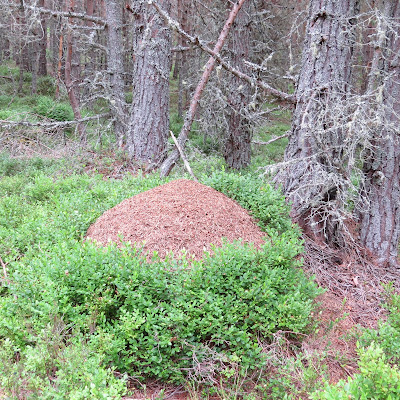 |
| Wood Ants nest |
Wood Ants are at their most active in the summer months, and walks in local forests revealed several huge nests, with thousands of worker ants frenziedly collecting and delivering caterpillars, insects and even beetles many times their own size!
So it looks like July 2016, despite the somewhat changeable weather, actually turned out to be another very good wildlife watching month in the Cairngorms National Park, with many memorable moments and lots of local specialities seen and enjoyed....happy days!! Though I must confess that I always tend to feel just a little sad at the end of every July , as I know that many of our summer visiting birds are soon to vacate our area and fly south to warmer climes as summer turns to early autumn next month.....
 |
| Sunset over the Moray Firth |











